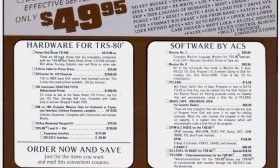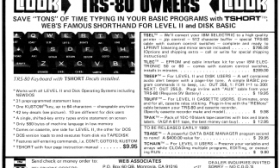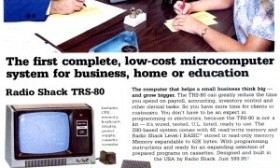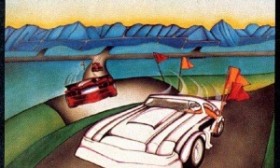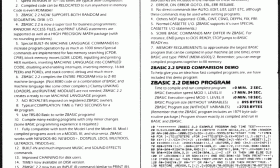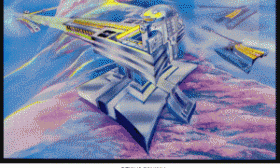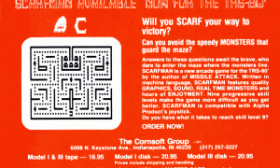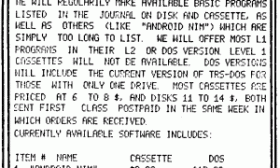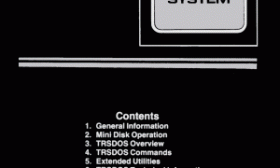Articles in the "Software" Category
Games by Wayne Westmoreland and Terry Gilman
Wayne Westmoreland and Terry Gilman wrote some excellent games for the TRS-80 from 1981 to 1983, including Sea Dragon and Armored Patrol. In 1995, Wayne Westmoreland released all of those games into the public domain.
Here is a description, written by Wayne Westmoreland in 1995, for each of the games.
TSHORT
After upgrading their TRS-80 Model I to Level II BASIC, many people missed the “shorthand dialect” of Level I BASIC. TSHORT was a very popular keyboard macro utility for Level II BASIC that added a similar kind of shorthand for BASIC commands. It was written by Ron Wirth and released in 1979 by Web Associates for $9.95. (The name Web Associates was not a reference to the World Wide Web, which it predated by ten years.) TSHORT ran in high memory above BASIC and consumed only 580 bytes of memory.Level I BASIC
When the TRS-80 Model I was first released in 1977, the BASIC interpreter that Microsoft was writing, Level II BASIC, was still months away from completion. Instead the Model I originally shipped with a BASIC interpreter known as Level I BASIC.
Level I BASIC was based on “Palo Alto Tiny BASIC”, a 2K version of Tiny BASIC written by Dr. Li-Chen Wang for the May 1976 issue of Dr. Dobb’s Journal. Because Dr. Li Chen-Wang placed his BASIC in the public domain (he labeled it “@COPYLEFT; ALL WRONGS RESERVED”), Steve Leininger, the designer of the TRS-80, was able to use it as a starting point. He added floating point math, cassette, keyboard, and video routines, doubling the size of the original code to 4K.
Rally
Rally was written by J. Weaver Jr. (Factory Programming) and distributed by Soft Sector Marketing. Rally was based on Rally-X, which was released by Namco in 1980.
The goal in Rally is to collect all of the flags in a maze, while avoiding “enemy cars”. Touching an enemy car causes you to lose your life.
ZBASIC
ZBASIC is probably the most popular BASIC compiler ever written for the TRS-80. It holds the distinction of being one of the few programs originally created for the TRS-80 that is still being developed in some form.
The first version of ZBASIC was written in 1979 by Andrew Gariepy for the Model I and sold by Simutek Computer Products. ZBASIC began appearing in Simutek advertisements in 1980. It originally cost $99.00 for the tape version and $129.00 for the disk version.
ZBASIC fell somewhere between a traditional compiler and an interpreter. As an early advertisement described it:
Devil's Tower
Devil’s Tower was written by John Olsen and released by Fantastic Software in 1982.
The player starts the game on the left, separated from the Attackers by a tall mountain in the center of the screen. The goal is to shoot over the mountain and destroy the Attackers on the other side. To complicate matters, the Attackers shoot back at you, often displaying an uncanny ability to predict where you are moving.
Scarfman
Scarfman was based on the arcade game Pac-Man, which was released by Namco in 1980. It was written by Philip Oliver and distributed by the Cornsoft Group. The Cornsoft Group also released a version of Scarfman for the Color Computer.
The game starts with you (the “Scarfman”) at the bottom of the screen. Like Pac-Man, the goal of Scarfman is to eat all of the dots on the screen. You earn points for every dot eaten.
Android Nim
Android Nim was Leo Christopherson’s first game for the TRS-80. It was featured on the cover of 80-Northwest Journal (later 80-U.S. Journal) in November 1978 and was released by 80-NW Publishing (later 80-U.S. Software). The cost was $8.00 for cassette and $13.00 for disk, with a $2.00 discount for 80-Northwest Journal subscribers. The game helped to popularize the magazine, and 80-U.S. Journal used an android for its mascot until 1981.
Soon after the original release, Leo Christopherson enhanced Android Nim with sound and more animation, developing the techniques known as “string-packing” and “line-packing” in the process. The enhanced version of Android Nim cost $14.95. Like all of Leo Christopherson’s TRS–80 games, Android Nim was written in combination of BASIC and machine language.
